Numeracy Learning and Teaching: Assessment Processes and Tool Analysis
VerifiedAdded on 2022/12/28
|6
|1217
|38
Report
AI Summary
This report provides a comprehensive analysis of numeracy learning and teaching, focusing on initial and diagnostic assessment processes for post-compulsory mathematics. It critically evaluates the use of multiple-choice questions as a specific assessment tool, considering its validity, reliability, efficiency, and equality of access. The report also discusses the importance of goal setting in organizing the mathematical program and facilitating the use of technology to enhance learners' analytical thinking. The advantages and disadvantages of multiple-choice questions are considered in relation to assessing conceptual clarity and problem-solving skills. The document concludes that both initial and diagnostic assessments are crucial for post-compulsory mathematical assessment, and despite some arguments against it, multiple choice questions can be effectively used in the assessment process. Desklib provides access to similar solved assignments and study resources for students.
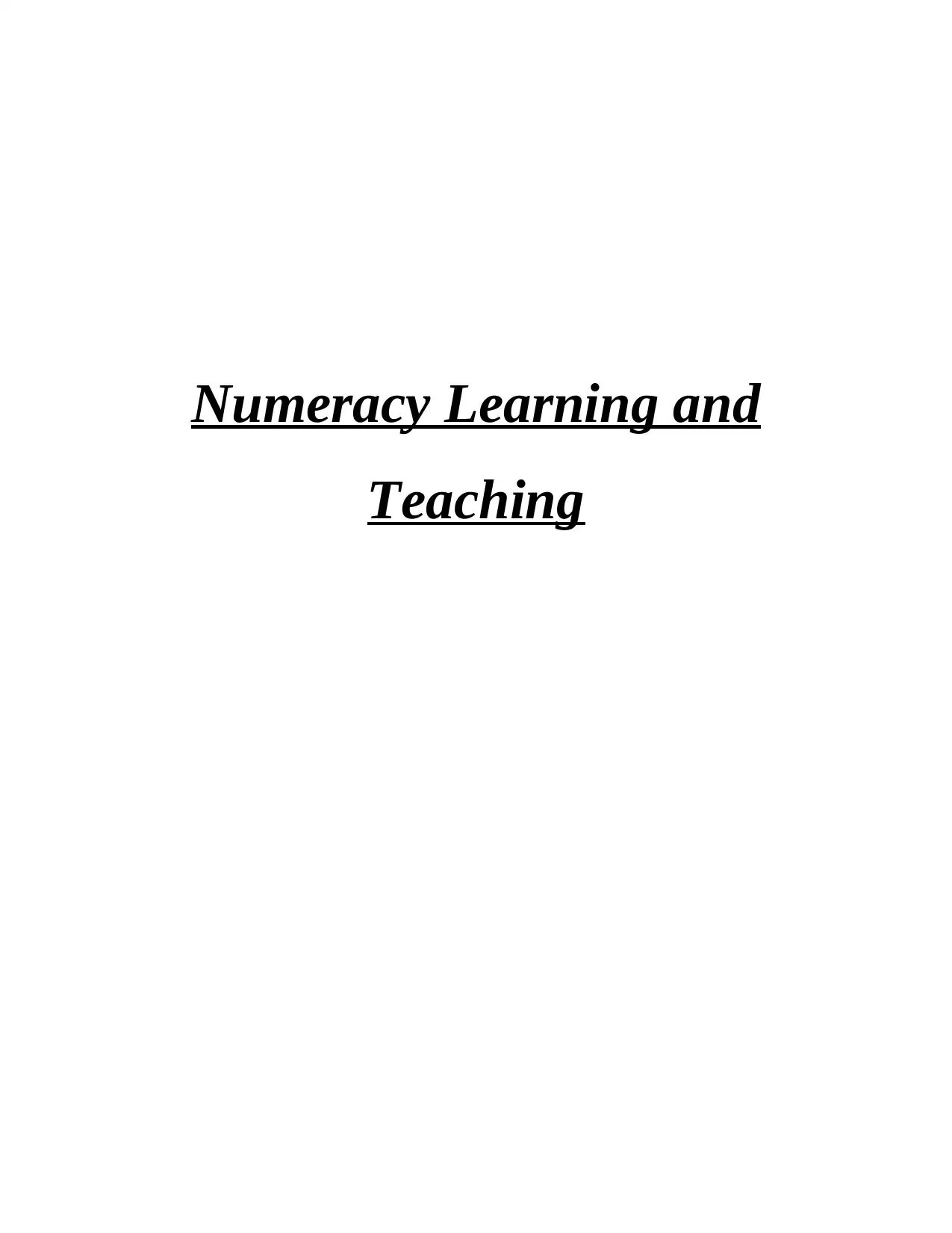
Numeracy Learning and
Teaching
Teaching
Paraphrase This Document
Need a fresh take? Get an instant paraphrase of this document with our AI Paraphraser
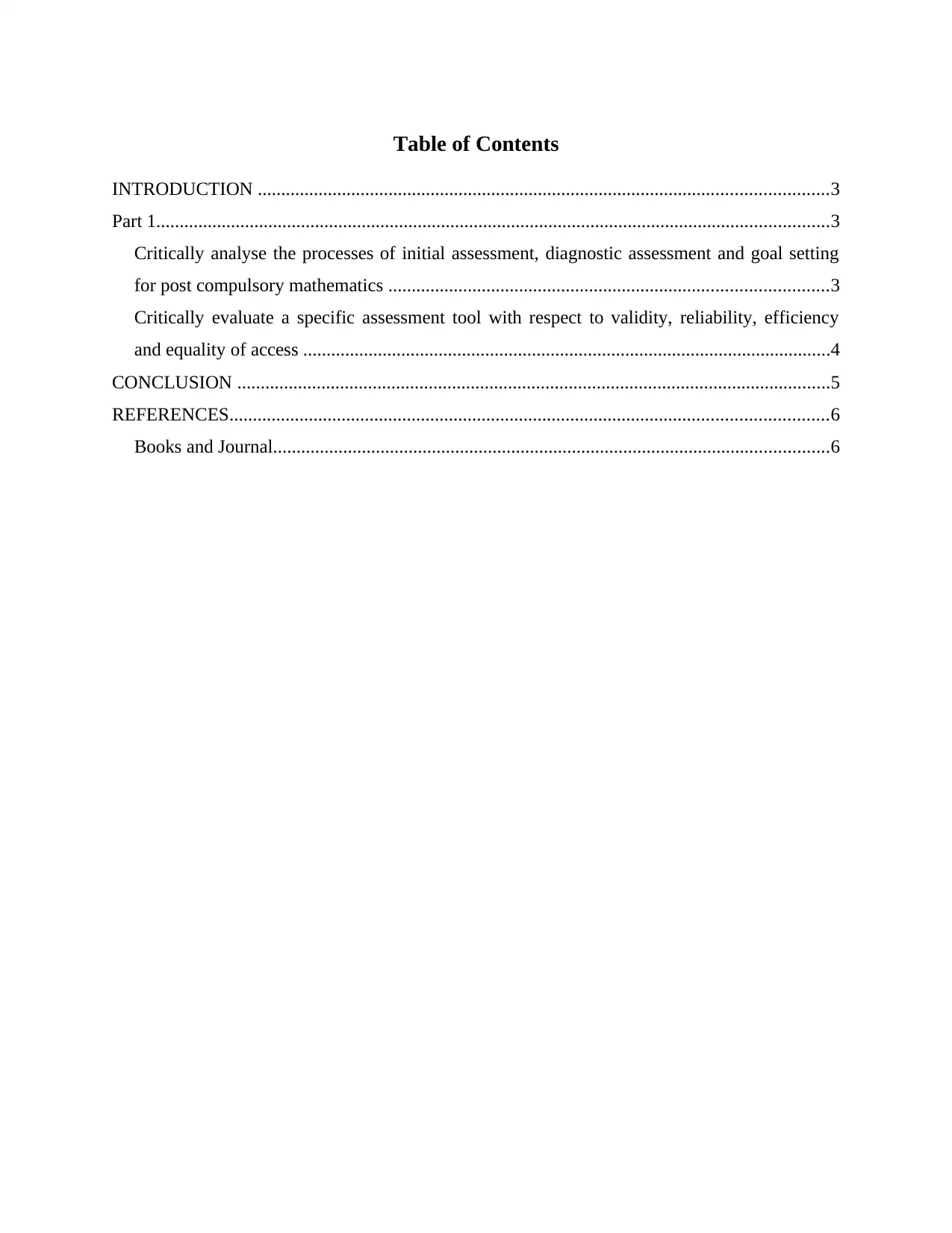
Table of Contents
INTRODUCTION ..........................................................................................................................3
Part 1................................................................................................................................................3
Critically analyse the processes of initial assessment, diagnostic assessment and goal setting
for post compulsory mathematics ..............................................................................................3
Critically evaluate a specific assessment tool with respect to validity, reliability, efficiency
and equality of access .................................................................................................................4
CONCLUSION ...............................................................................................................................5
REFERENCES................................................................................................................................6
Books and Journal.......................................................................................................................6
INTRODUCTION ..........................................................................................................................3
Part 1................................................................................................................................................3
Critically analyse the processes of initial assessment, diagnostic assessment and goal setting
for post compulsory mathematics ..............................................................................................3
Critically evaluate a specific assessment tool with respect to validity, reliability, efficiency
and equality of access .................................................................................................................4
CONCLUSION ...............................................................................................................................5
REFERENCES................................................................................................................................6
Books and Journal.......................................................................................................................6
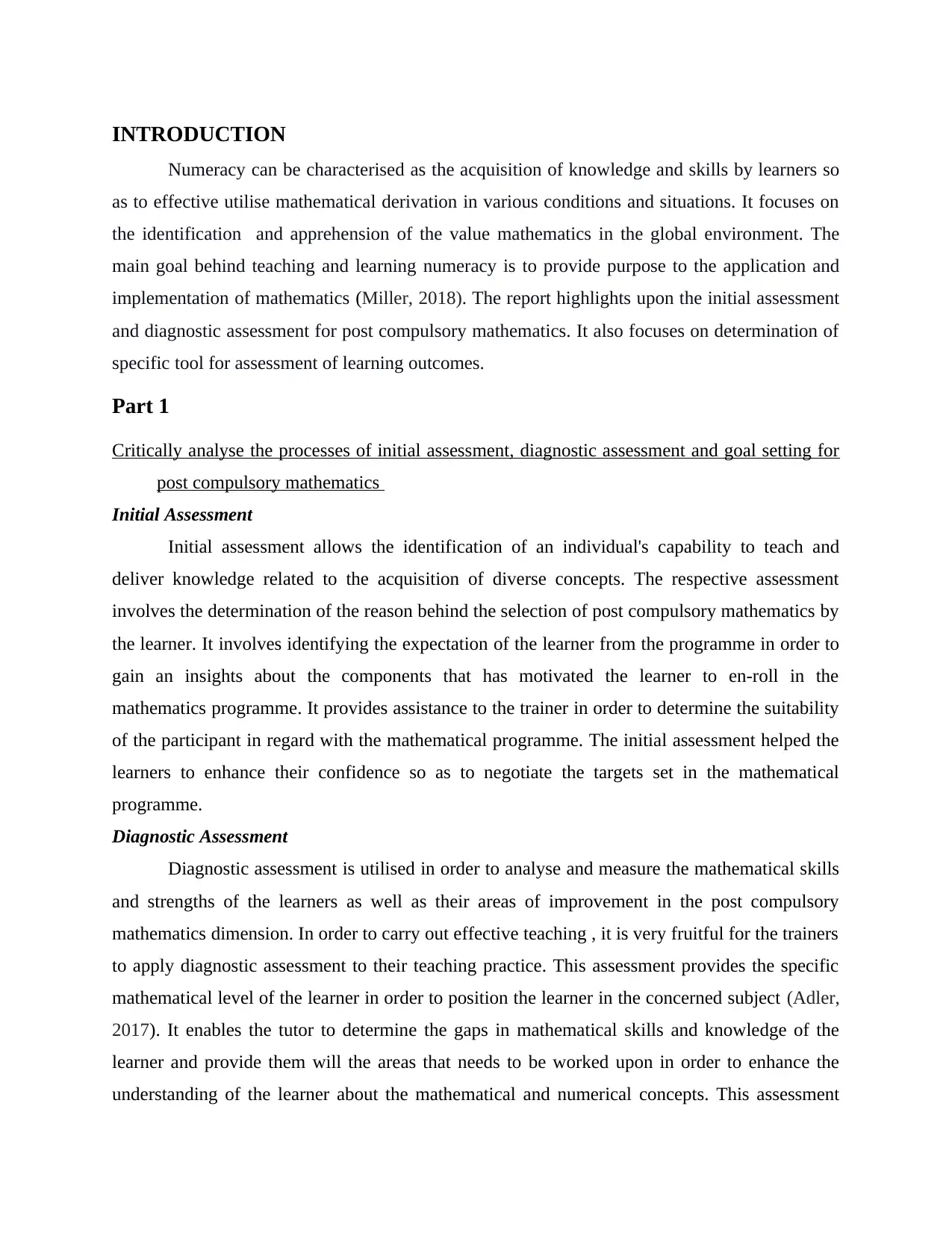
INTRODUCTION
Numeracy can be characterised as the acquisition of knowledge and skills by learners so
as to effective utilise mathematical derivation in various conditions and situations. It focuses on
the identification and apprehension of the value mathematics in the global environment. The
main goal behind teaching and learning numeracy is to provide purpose to the application and
implementation of mathematics (Miller, 2018). The report highlights upon the initial assessment
and diagnostic assessment for post compulsory mathematics. It also focuses on determination of
specific tool for assessment of learning outcomes.
Part 1
Critically analyse the processes of initial assessment, diagnostic assessment and goal setting for
post compulsory mathematics
Initial Assessment
Initial assessment allows the identification of an individual's capability to teach and
deliver knowledge related to the acquisition of diverse concepts. The respective assessment
involves the determination of the reason behind the selection of post compulsory mathematics by
the learner. It involves identifying the expectation of the learner from the programme in order to
gain an insights about the components that has motivated the learner to en-roll in the
mathematics programme. It provides assistance to the trainer in order to determine the suitability
of the participant in regard with the mathematical programme. The initial assessment helped the
learners to enhance their confidence so as to negotiate the targets set in the mathematical
programme.
Diagnostic Assessment
Diagnostic assessment is utilised in order to analyse and measure the mathematical skills
and strengths of the learners as well as their areas of improvement in the post compulsory
mathematics dimension. In order to carry out effective teaching , it is very fruitful for the trainers
to apply diagnostic assessment to their teaching practice. This assessment provides the specific
mathematical level of the learner in order to position the learner in the concerned subject (Adler,
2017). It enables the tutor to determine the gaps in mathematical skills and knowledge of the
learner and provide them will the areas that needs to be worked upon in order to enhance the
understanding of the learner about the mathematical and numerical concepts. This assessment
Numeracy can be characterised as the acquisition of knowledge and skills by learners so
as to effective utilise mathematical derivation in various conditions and situations. It focuses on
the identification and apprehension of the value mathematics in the global environment. The
main goal behind teaching and learning numeracy is to provide purpose to the application and
implementation of mathematics (Miller, 2018). The report highlights upon the initial assessment
and diagnostic assessment for post compulsory mathematics. It also focuses on determination of
specific tool for assessment of learning outcomes.
Part 1
Critically analyse the processes of initial assessment, diagnostic assessment and goal setting for
post compulsory mathematics
Initial Assessment
Initial assessment allows the identification of an individual's capability to teach and
deliver knowledge related to the acquisition of diverse concepts. The respective assessment
involves the determination of the reason behind the selection of post compulsory mathematics by
the learner. It involves identifying the expectation of the learner from the programme in order to
gain an insights about the components that has motivated the learner to en-roll in the
mathematics programme. It provides assistance to the trainer in order to determine the suitability
of the participant in regard with the mathematical programme. The initial assessment helped the
learners to enhance their confidence so as to negotiate the targets set in the mathematical
programme.
Diagnostic Assessment
Diagnostic assessment is utilised in order to analyse and measure the mathematical skills
and strengths of the learners as well as their areas of improvement in the post compulsory
mathematics dimension. In order to carry out effective teaching , it is very fruitful for the trainers
to apply diagnostic assessment to their teaching practice. This assessment provides the specific
mathematical level of the learner in order to position the learner in the concerned subject (Adler,
2017). It enables the tutor to determine the gaps in mathematical skills and knowledge of the
learner and provide them will the areas that needs to be worked upon in order to enhance the
understanding of the learner about the mathematical and numerical concepts. This assessment
⊘ This is a preview!⊘
Do you want full access?
Subscribe today to unlock all pages.

Trusted by 1+ million students worldwide
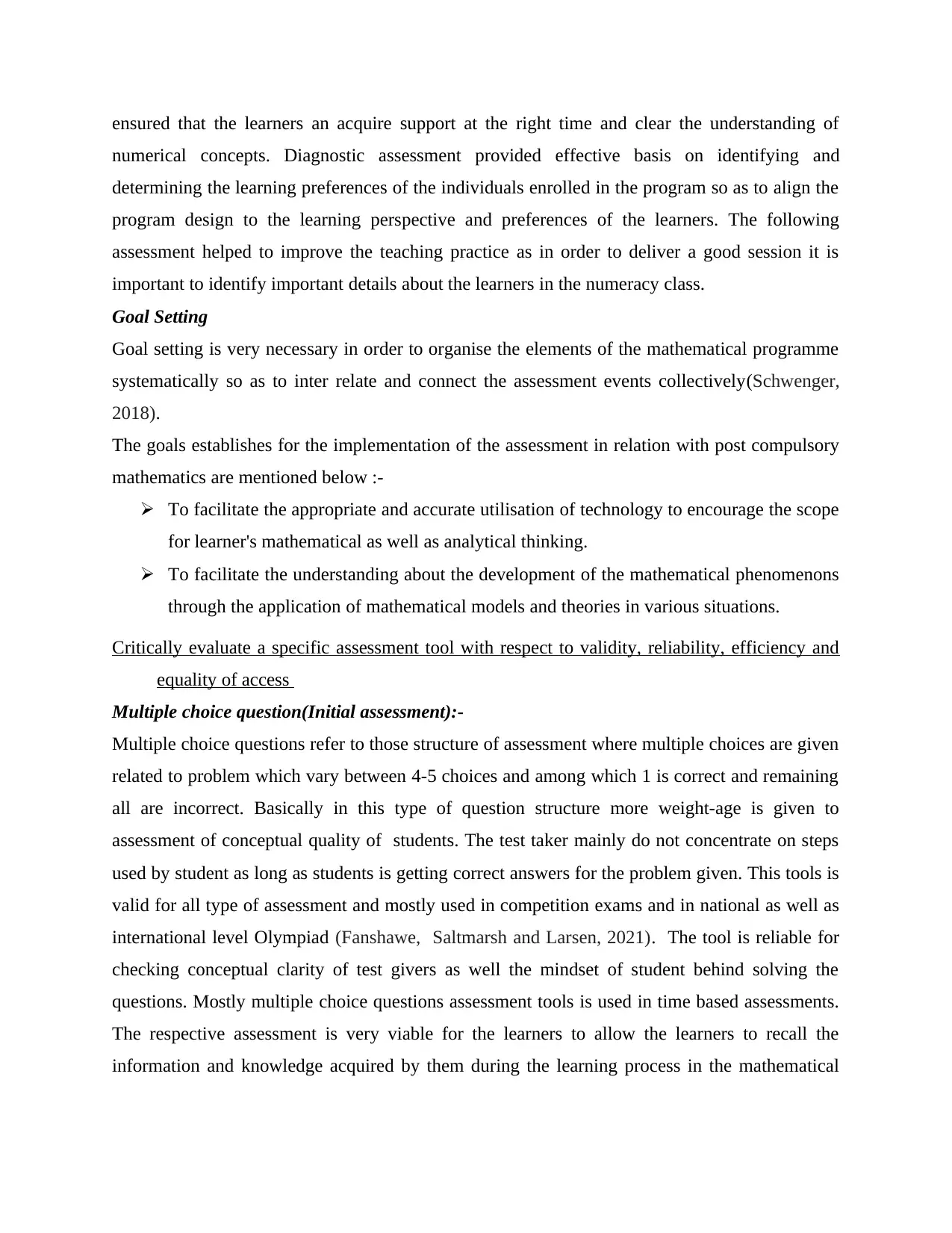
ensured that the learners an acquire support at the right time and clear the understanding of
numerical concepts. Diagnostic assessment provided effective basis on identifying and
determining the learning preferences of the individuals enrolled in the program so as to align the
program design to the learning perspective and preferences of the learners. The following
assessment helped to improve the teaching practice as in order to deliver a good session it is
important to identify important details about the learners in the numeracy class.
Goal Setting
Goal setting is very necessary in order to organise the elements of the mathematical programme
systematically so as to inter relate and connect the assessment events collectively(Schwenger,
2018).
The goals establishes for the implementation of the assessment in relation with post compulsory
mathematics are mentioned below :-
To facilitate the appropriate and accurate utilisation of technology to encourage the scope
for learner's mathematical as well as analytical thinking.
To facilitate the understanding about the development of the mathematical phenomenons
through the application of mathematical models and theories in various situations.
Critically evaluate a specific assessment tool with respect to validity, reliability, efficiency and
equality of access
Multiple choice question(Initial assessment):-
Multiple choice questions refer to those structure of assessment where multiple choices are given
related to problem which vary between 4-5 choices and among which 1 is correct and remaining
all are incorrect. Basically in this type of question structure more weight-age is given to
assessment of conceptual quality of students. The test taker mainly do not concentrate on steps
used by student as long as students is getting correct answers for the problem given. This tools is
valid for all type of assessment and mostly used in competition exams and in national as well as
international level Olympiad (Fanshawe, Saltmarsh and Larsen, 2021). The tool is reliable for
checking conceptual clarity of test givers as well the mindset of student behind solving the
questions. Mostly multiple choice questions assessment tools is used in time based assessments.
The respective assessment is very viable for the learners to allow the learners to recall the
information and knowledge acquired by them during the learning process in the mathematical
numerical concepts. Diagnostic assessment provided effective basis on identifying and
determining the learning preferences of the individuals enrolled in the program so as to align the
program design to the learning perspective and preferences of the learners. The following
assessment helped to improve the teaching practice as in order to deliver a good session it is
important to identify important details about the learners in the numeracy class.
Goal Setting
Goal setting is very necessary in order to organise the elements of the mathematical programme
systematically so as to inter relate and connect the assessment events collectively(Schwenger,
2018).
The goals establishes for the implementation of the assessment in relation with post compulsory
mathematics are mentioned below :-
To facilitate the appropriate and accurate utilisation of technology to encourage the scope
for learner's mathematical as well as analytical thinking.
To facilitate the understanding about the development of the mathematical phenomenons
through the application of mathematical models and theories in various situations.
Critically evaluate a specific assessment tool with respect to validity, reliability, efficiency and
equality of access
Multiple choice question(Initial assessment):-
Multiple choice questions refer to those structure of assessment where multiple choices are given
related to problem which vary between 4-5 choices and among which 1 is correct and remaining
all are incorrect. Basically in this type of question structure more weight-age is given to
assessment of conceptual quality of students. The test taker mainly do not concentrate on steps
used by student as long as students is getting correct answers for the problem given. This tools is
valid for all type of assessment and mostly used in competition exams and in national as well as
international level Olympiad (Fanshawe, Saltmarsh and Larsen, 2021). The tool is reliable for
checking conceptual clarity of test givers as well the mindset of student behind solving the
questions. Mostly multiple choice questions assessment tools is used in time based assessments.
The respective assessment is very viable for the learners to allow the learners to recall the
information and knowledge acquired by them during the learning process in the mathematical
Paraphrase This Document
Need a fresh take? Get an instant paraphrase of this document with our AI Paraphraser
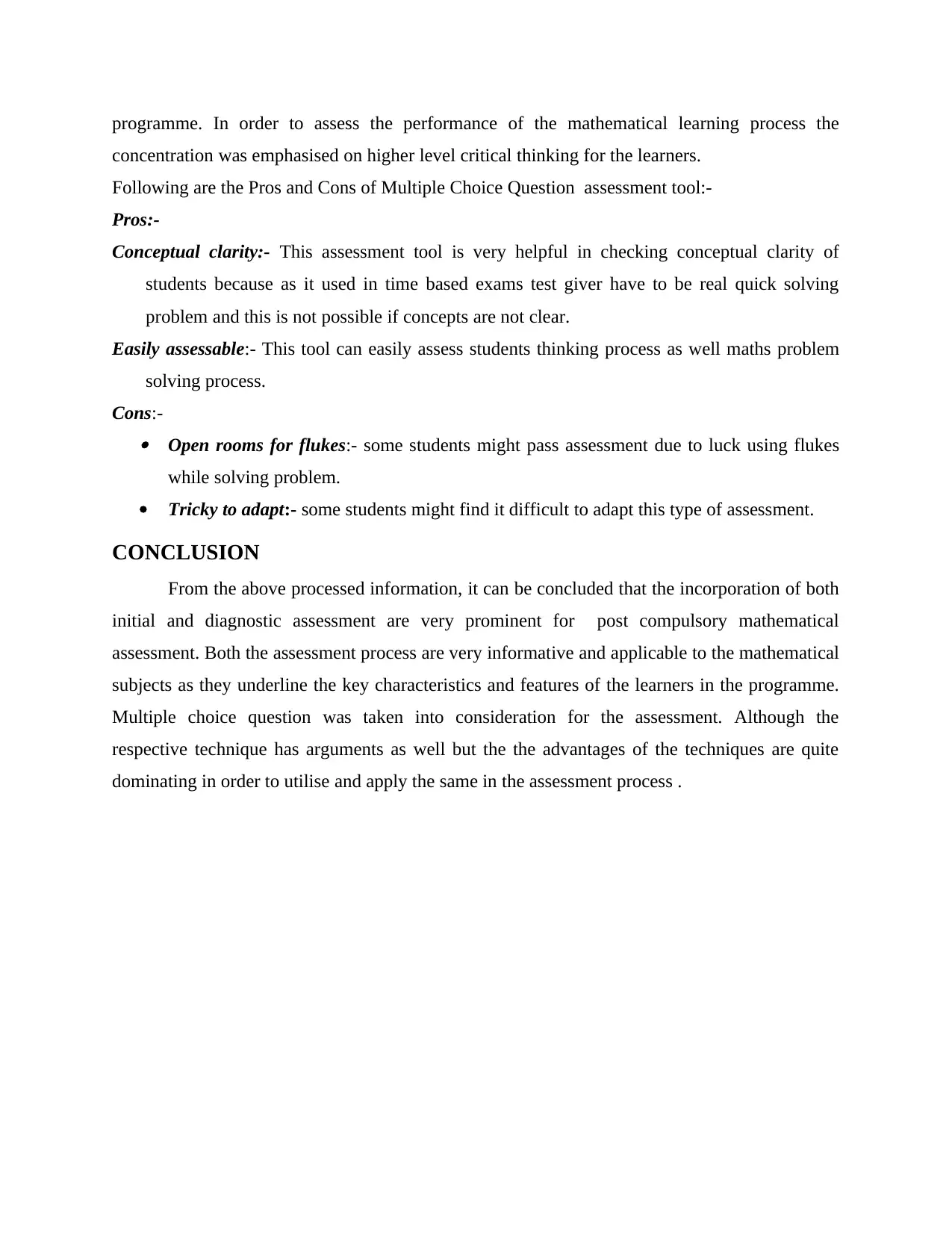
programme. In order to assess the performance of the mathematical learning process the
concentration was emphasised on higher level critical thinking for the learners.
Following are the Pros and Cons of Multiple Choice Question assessment tool:-
Pros:-
Conceptual clarity:- This assessment tool is very helpful in checking conceptual clarity of
students because as it used in time based exams test giver have to be real quick solving
problem and this is not possible if concepts are not clear.
Easily assessable:- This tool can easily assess students thinking process as well maths problem
solving process.
Cons:- Open rooms for flukes:- some students might pass assessment due to luck using flukes
while solving problem.
Tricky to adapt:- some students might find it difficult to adapt this type of assessment.
CONCLUSION
From the above processed information, it can be concluded that the incorporation of both
initial and diagnostic assessment are very prominent for post compulsory mathematical
assessment. Both the assessment process are very informative and applicable to the mathematical
subjects as they underline the key characteristics and features of the learners in the programme.
Multiple choice question was taken into consideration for the assessment. Although the
respective technique has arguments as well but the the advantages of the techniques are quite
dominating in order to utilise and apply the same in the assessment process .
concentration was emphasised on higher level critical thinking for the learners.
Following are the Pros and Cons of Multiple Choice Question assessment tool:-
Pros:-
Conceptual clarity:- This assessment tool is very helpful in checking conceptual clarity of
students because as it used in time based exams test giver have to be real quick solving
problem and this is not possible if concepts are not clear.
Easily assessable:- This tool can easily assess students thinking process as well maths problem
solving process.
Cons:- Open rooms for flukes:- some students might pass assessment due to luck using flukes
while solving problem.
Tricky to adapt:- some students might find it difficult to adapt this type of assessment.
CONCLUSION
From the above processed information, it can be concluded that the incorporation of both
initial and diagnostic assessment are very prominent for post compulsory mathematical
assessment. Both the assessment process are very informative and applicable to the mathematical
subjects as they underline the key characteristics and features of the learners in the programme.
Multiple choice question was taken into consideration for the assessment. Although the
respective technique has arguments as well but the the advantages of the techniques are quite
dominating in order to utilise and apply the same in the assessment process .
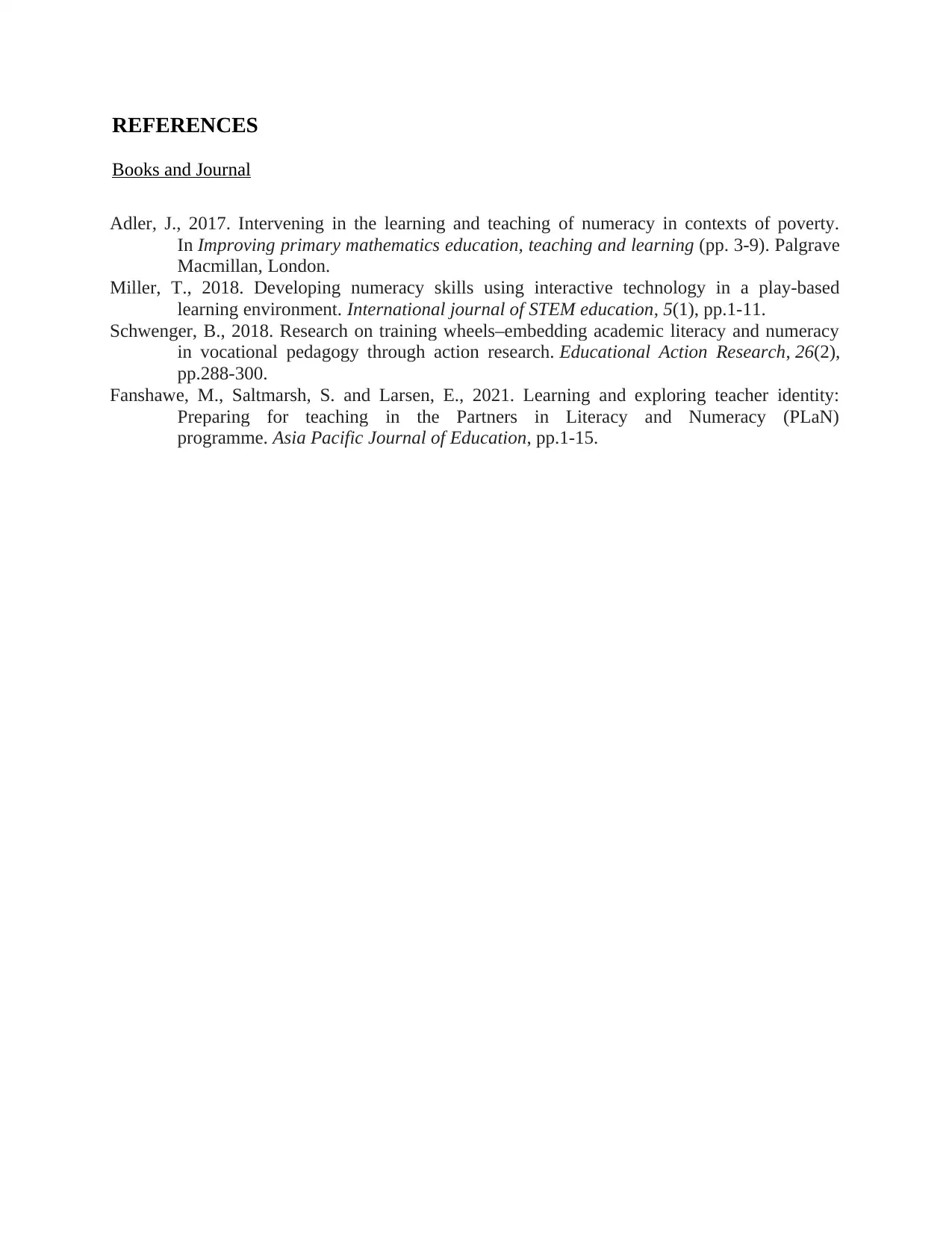
REFERENCES
Books and Journal
Adler, J., 2017. Intervening in the learning and teaching of numeracy in contexts of poverty.
In Improving primary mathematics education, teaching and learning (pp. 3-9). Palgrave
Macmillan, London.
Miller, T., 2018. Developing numeracy skills using interactive technology in a play-based
learning environment. International journal of STEM education, 5(1), pp.1-11.
Schwenger, B., 2018. Research on training wheels–embedding academic literacy and numeracy
in vocational pedagogy through action research. Educational Action Research, 26(2),
pp.288-300.
Fanshawe, M., Saltmarsh, S. and Larsen, E., 2021. Learning and exploring teacher identity:
Preparing for teaching in the Partners in Literacy and Numeracy (PLaN)
programme. Asia Pacific Journal of Education, pp.1-15.
Books and Journal
Adler, J., 2017. Intervening in the learning and teaching of numeracy in contexts of poverty.
In Improving primary mathematics education, teaching and learning (pp. 3-9). Palgrave
Macmillan, London.
Miller, T., 2018. Developing numeracy skills using interactive technology in a play-based
learning environment. International journal of STEM education, 5(1), pp.1-11.
Schwenger, B., 2018. Research on training wheels–embedding academic literacy and numeracy
in vocational pedagogy through action research. Educational Action Research, 26(2),
pp.288-300.
Fanshawe, M., Saltmarsh, S. and Larsen, E., 2021. Learning and exploring teacher identity:
Preparing for teaching in the Partners in Literacy and Numeracy (PLaN)
programme. Asia Pacific Journal of Education, pp.1-15.
⊘ This is a preview!⊘
Do you want full access?
Subscribe today to unlock all pages.

Trusted by 1+ million students worldwide
1 out of 6
Related Documents
Your All-in-One AI-Powered Toolkit for Academic Success.
+13062052269
info@desklib.com
Available 24*7 on WhatsApp / Email
![[object Object]](/_next/static/media/star-bottom.7253800d.svg)
Unlock your academic potential
Copyright © 2020–2025 A2Z Services. All Rights Reserved. Developed and managed by ZUCOL.





